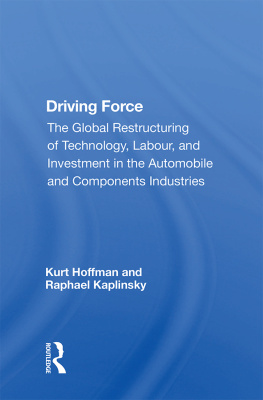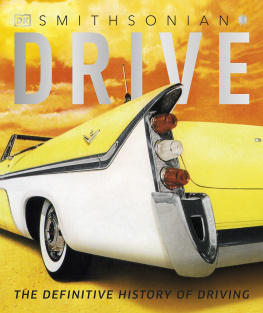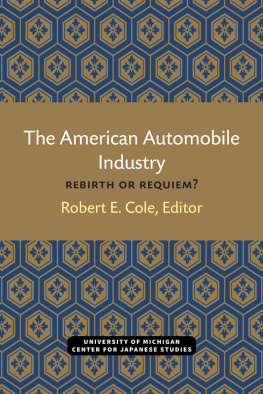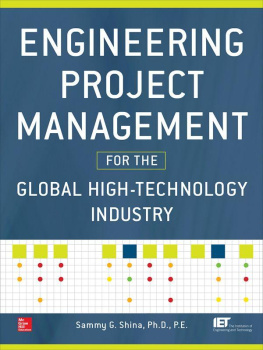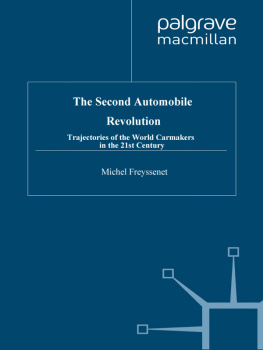Driving Force
The Global Restructuring of Technology, Labour, and Investment in the Automobile and Components Industries
Published in cooperation
with the
United Nations Centre on Transnational Corporations
Driving Force
The Global Restructuring of Technology, Labour, and Investment in the Automobile and Components Industries
Kurt Hoffman
and Raphael Kaplinsky
First published 1988 by Westview Press, Inc.
Published 2018 by Routledge
52 Vanderbilt Avenue, New York, NY 10017
2 Park Square, Milton Park, Abingdon, Oxon OX14 4RN
Routledge is an imprint of the Taylor & Francis Group, an informa business
Copyright 1988 Taylor & Francis
All rights reserved. No part of this book may be reprinted or reproduced or utilised in any form or by any electronic, mechanical, or other means, now known or hereafter invented, including photocopying and recording, or in any information storage or retrieval system, without permission in writing from the publishers.
Notice:
Product or corporate names may be trademarks or registered trademarks, and are used only for identification and explanation without intent to infringe.
Cover design: Petra Bhr Rovendaal
Library of Congress CataloginginPublication Data
Hoffman, Kurt
Driving force: the global restructuring of technology,
labour, and investment in the automobile and components
industries/by Kurt Hoffman and Raphael Kaplinsky.
p. cm.--(Westview special studies in international
economics and business)
ISBN 0-8133-7502-9
1. Automobile industry and trade--International cooperation.
2. Automobile supplies industry--International cooperation.
3. Automobile industry and trade--Automation. 4. Automobile
supplies industry--Automation. 5. International division of labor.
6. International business enterprises. 7. Investments, Foreign.
I. Kaplinsky, Raphael. II. Title. III. Series.
HD9710.A2H64 1988
338.4'76292--dc19 87-28015
CIP
ISBN 13: 978-0-367-01433-9 (hbk)
One of the most striking features of the world economy in recent years is the rapid pace of technological change. New technologies have often been quite visible, as in the proliferation of personal computers, the growth of electronics components in automobiles, and the spread of a variety of consumer products whose performance is derived from computer chips. Less visible but potentially of greater importance are changes that are underway in how production is organized in key sectors of manufacturing, many of which are also linked to developments in electronics.
The United Nations Centre on Transnational Corporations (UNCTC) has conducted a number of studies on the role of transnational corporations (TNCs) in contributing to the economic development of developing countries. UNCTC has been especially interested in how TNCs transfer technology, and in how their activities can stimulate the growth of modern manufacturing industries in developing countries. The present study continues UNCTC work in this area. The study presents a detailed analysis of how production processes are being transformed in the manufacture and assembly of automobiles and automobile components, the role of TNCs in those transformations, and the possible implications for developing countries.
The automobile industry has long been thought to be accessible to many developing country producers, both to produce for domestic markets and to export components and finished vehicles to the large markets in the developed market economies. Although automobiles are a mature industry with product and production technologies that have been widely disseminated, this study shows that there is still substantial scope for TNCs to achieve competitive advantages through the application of micro-electronics-based automation systems, and by virtue of the lower cost and flexibility gained from the re-organization of production. What is not clear is whether the advantages gained by firms will result in advantages to countries. This study raises the possibility that the new production methods, combined with increasing protectionist sentiment within the developed market economics, could lead to a reduction in the volume of automobile production within developing countries. While this remains a possibility, and is not yet a reality, the consequences of such a development are evident. For that reason, the present study deserves widespread attention.
The study was sponsored by UNCTC, and we are pleased to make it available to a wide audience. The methodology was devised and carried out by the authors and they are responsible for the research, writing and editing. The manuscript was not subject to United Nations editing procedures. UNCTC would like to thank Kurt Hoffmann of the Science Policy Research Unit and Raphael Kaplinsky of the Institute of Development Studies, both at the University of Sussex, United Kingdom, for their efforts in conducting the research and writing the study. Special thanks are due to Haleem Lone who assisted with the historical section in and Irene Williams who was responsible for the layout.
Peter Hansen
Executive Director
United Nations Centre on Transnational Corporations
1
Transnational Corporations and the New International Division of Labour
This book is, in the first instance, concerned with the past evolution and future direction of the international division of labour in manufacturing. More specifically we are trying to locate the role played by two major sets of actors in global manufacturing - the developing countries (DCs) and the transnational corporations (TNCs). Will the DCs increase their share of global manufacturing production? Which DCs will fare most successfully? Will the TNC be an important facilitator of the industrial progress of DCs, both in relation to producing for indigenous markets and as a conduit for production destined for industrially advanced country (IAC) markets? And will there be important differences between sectors?
These are complicated issues which find no easy answer. In part this is because the very complexity of the subject-matter clouds the crystal-ball, making accurate prediction difficult. But it also stems from the inherent indeterminacy of these events which will in the end be conditioned by a confluence of economic, social and political factors. These in their turn are subject to the decisions and actions of individual decision-takers - be they in the TNC or the state, in IACs or DCs.
In these first two chapters our primary concern is to set the background for the empirical study which follows in later chapters. The industrial advance of the DCs will be mapped out, pointing to the important role played in this by the TNCs. But these events must necessarily be recounted in historical context, especially in relation to the emergence of the economic downturn experienced by much of the global economy since the early 1970s. This downturn - often referred to as "crisis" considers the dimensions which characterize the current economic crisis and the transition to a new social and economic order. In subsequent chapters we will focus on the way in which these events are being worked through on a global scale in a single sector - namely automobiles - and we will conclude with a consideration of the general impact of these events on other sectors and thus on the international division of labour in manufacturing.

